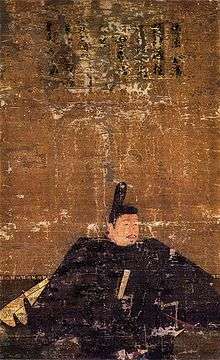Ashikaga Yoshiakira
| Ashikaga Yoshiakira 足利 義詮 | |
|---|---|
 | |
| Shōgun | |
|
In office 1358–1367 | |
| Monarch | Chōkei |
| Preceded by | Ashikaga Takauji |
| Succeeded by | Ashikaga Yoshimitsu |
| Personal details | |
| Born | July 4, 1330 |
| Died | December 28, 1367 (aged 37) |
| Spouse(s) | Shibukawa Kōshi |
| Children |
Among others... |
| Parents |
|
Ashikaga Yoshiakira (足利 義詮, July 4, 1330 – December 28, 1367) was the 2nd shōgun of the Ashikaga shogunate who reigned from 1358 to 1367 during the Muromachi period of Japan. Yoshiakira was the son of the founder and first shōgun of the Muromachi shogunate, Ashikaga Takauji. His mother was Akahashi Tōshi, also known as Hōjō Nariko.[1]
His childhood name was Senjuō (千寿王). He spent his childhood in Kamakura as a hostage of the Hōjō clan. His father Takauji joined forces with the banished Emperor Go-Daigo. The Kamakura shogunate was overthrown, and Go-Daigo began the process which came to be known as the Kenmu Restoration.[2]
Yoshiakira assisted Nitta Yoshisada (1301–1338) in his attack on the Kamakura shogunate.[3]
In 1349, an internal disturbance of the government caused Yoshiakira to be called back to Kyoto, where he found himself named as Takauji's heir. On 5 April 1352, Loyalist forces led by Kitabatake Akiyoshi, Kusunoki Masanori and Chigusa Akitsune occupied Kyoto for twenty days before Yoshiakira was able to retake the city. Loyalist forces led by Masanori and Yamana Tokiuji captured Kyoto again in July 1353, but were repulsed by Yoshiakira in August. In January 1355, Loyalist forces led by Momonoi, Tadafuyu, and Yamana captured Kyoto again. However, Kyoto was recaptured on 25 April by Takauji's and Yoshiakira's combined forces.[4] Yoshiakira succeeded his father Takauji as Sei-i Taishōgun after his death in 1358.[5]
Significant events shape the period during which Yoshiakira was shōgun:
- 1358 – Takauji dies; Yoshiakira appointed shōgun'7; dissention and defections in shogunate.[6]
- 1362 – Hosokawa Kiyouji and Kusunoki Masanori attack Kyoto, Yoshiakira flees, but regains the capital in twenty days.[6][4]:107–108
- 1365 – Emperor Go-Daigo's son, Prince Kaneyoshi (also known as Kanenaga) gains control of Kyushu.[6]
- 1367 – Kantō kubō Ashikaga Motouji dies;[6] Yoshiakira falls ill and cedes his position to his son.[7]
Some months after his death he was succeeded by his son Ashikaga Yoshimitsu, who became the third shōgun in 1368. Yoshiakira was posthumously named 宝篋院 (Hōkyōin), and his grave is at Tōji-in, Kyoto,[8] at the same site as his father's grave.[1]
Family
- Father: Ashikaga Takauji
- Mother: Akahashi Toshi (1306–1365)
- Wife: Shibukawa Koshi (1332–1392)
- Concubine: Kino Yoshiko (1336–1413)
- Children:
- Ashikaga Senjuo (1351–1355) by Koshi
- a boy by Yoshiko
- Ashikaga Yoshimitsu by Yoshiko
- Ashikaga Mitsuakira (1364–1414) by Yoshiko
- Kashiwabi Kiyokuni (d. 1398)
- Teiyou Soki (priest)
- Keiko (d. 1422) later Hokyoji-dono
Eras of Yoshiakira's bakufu
The years in which Yoshiakira was shōgun are more specifically identified by more than one era name or nengō.[9]
Nanboku-chō southern court
- Eras as reckoned by legitimate Court (as determined by Meiji rescript):
- Shōhei (1346–1370)
Nanboku-chō northern Court
Notes
- 1 2 "足利 義詮" [Ashikaga Yoshiakira]. Nihon Jinmei Daijiten (日本人名大辞典) (in Japanese). Tokyo: Shogakukan. 2012. Archived from the original on 2007-08-25. Retrieved 2012-07-31.
- ↑ Titsingh, Isaac. (1834). Annales des empereurs du japon, pp. 290–294., p. 290, at Google Books
- ↑ "足利義詮" [Ashikaga Yoshiakira]. Dijitaru Daijisen (in Japanese). Tokyo: Shogakukan. 2012. OCLC 56431036. Archived from the original on 2007-08-25. Retrieved 2012-07-31.
- 1 2 Sansom, George (1961). A History of Japan, 1334–1615. Stanford University Press. pp. 81, 87–89, 92–97. ISBN 0804705259.
- ↑ Titsingh, p. 304., p. 304, at Google Books
- 1 2 3 4 Ackroyd, Joyce. (1982) Lessons from History: The Tokushi Yoron, p. 329.
- ↑ Titsingh, p. 307., p. 307, at Google Books
- ↑ Titsingh,p. 308., p. 308, at Google Books
- ↑ Titsingh, pp. 304–308., p. 304, at Google Books
References
- Ackroyd, Joyce I. (1982) Lessons from History: the Tokushi Yoron. Brisbane: University of Queensland Press. ISBN 9780702214851; OCLC 7574544
- Sansom, George Bailey (1961). A History of Japan: 1334–1615. Stanford: Stanford University Press. ISBN 978-0-8047-0525-7; OCLC 43483194
- Titsingh, Isaac. (1834). Nihon Ōdai Ichiran; ou, Annales des empereurs du Japon. Paris: Royal Asiatic Society, Oriental Translation Fund of Great Britain and Ireland. OCLC 585069
| Preceded by Ashikaga Takauji |
Shōgun: Ashikaga Yoshiakira 1358–1367 |
Succeeded by Ashikaga Yoshimitsu |
